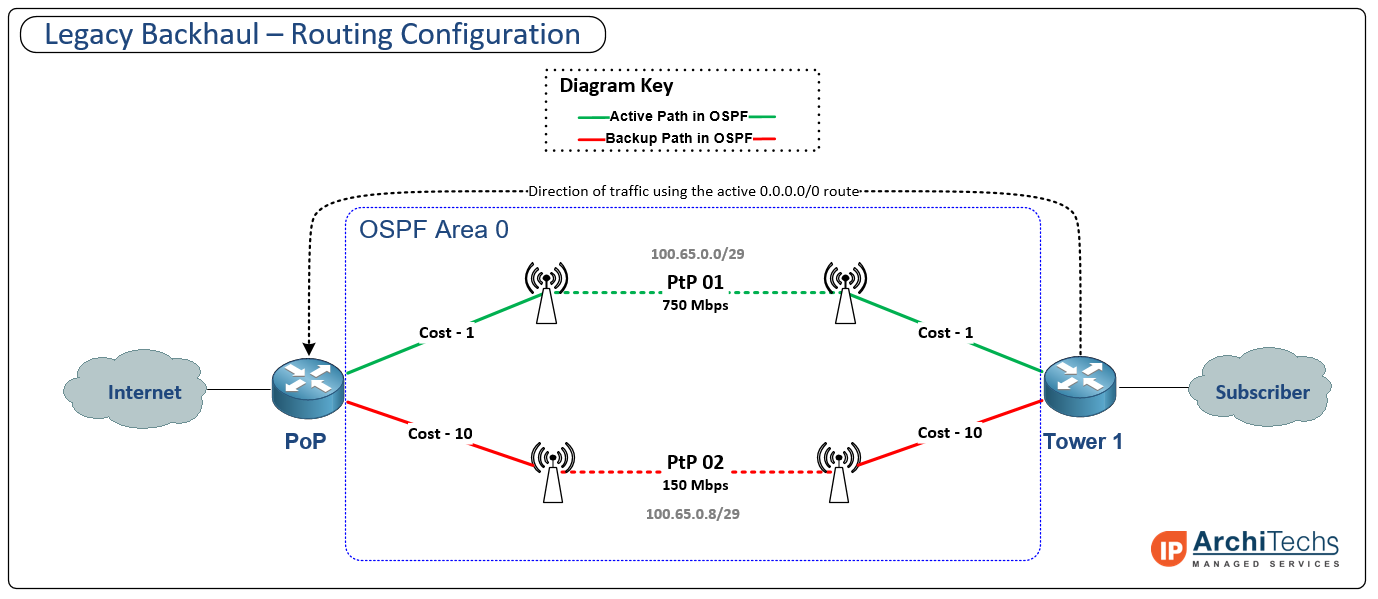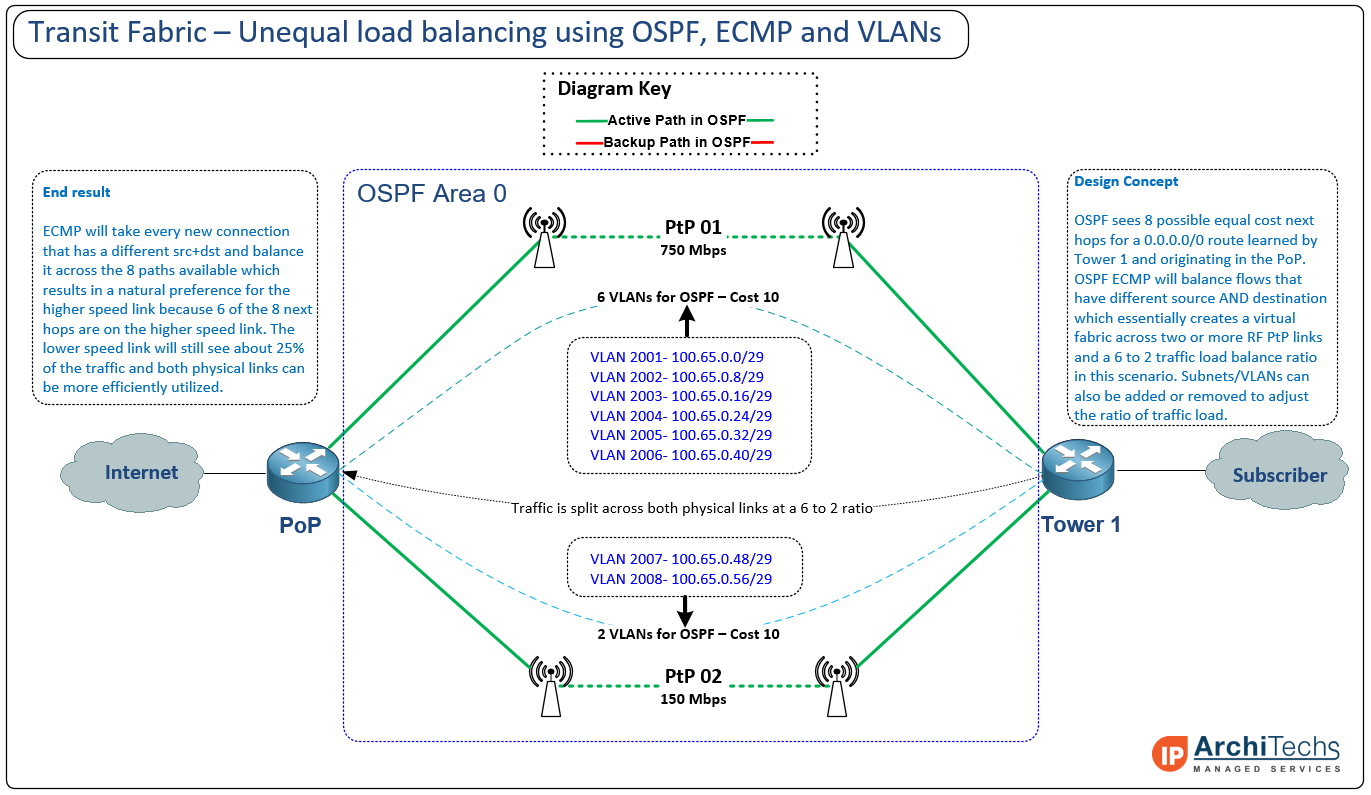Defining the problem – unused capacity
One of the single greatest challenges if you have ever owned, operated or designed a WISP (Wireless Internet Service Provider) is using all of the available bandwidth across multiple PtP links in the network. It is very common for two towers to have multiple RF PtP (Point-to-Point) links between them and run at different speeds. It is not unusual to have a primary link that runs at near-gigabit speeds and a backup link that may range anywhere from 50 Mbps to a few hundred Mbps.
This provides a pretty clean HA routing architecture, but it leaves capacity in the network unused until there is a failure. One of the headaches WISP designers always face is how to manage and engineer traffic for sub-rate ethernet links – essentially links that can’t deliver as much throughput as the physical link to the router or switch. In the fiber world, this is pretty straightforward as two links between any two points can be the exact same speed and either be channeled together with LACP or rely on ECMP with OSPF or BGP.
However, in the WISP world, this becomes problematic, as the links are unequal and neither channeling or ECMP has been an effective solution as it leaves bandwidth unused on the higher speed link.
Previous attempts to solve the problem
| Solution | Description/Caveats |
|---|---|
| Scripting / PCQ | Scripting and Per-Connection-Queuing is a technique that many have used with some success but it adds a moderate amount of complexity and struggles when the disparity between the speeds of links is more than 4 to 1. |
| Scripting / Routing Marks | Scripting and using routing marks allows you to change the next hop of traffic when a link reaches a certain capacity, but it also adds moderate complexity and adding a routing mark for anything beyond one extra link becomes tedious. |
| MPLS Traffic Engineering | MPLS Traffic Engineering has the distinct advantage of selecting exactly which hops traffic to a certain destination will take but it requires an experienced hand to get it working and some care and feeding to monitor and adjust the properties of the TE tunnels. MPLS TE is probably the most complex solution out of the 4 listed options. |
| External Load Balancer | This is the most effective solution as it can dynamically balance traffic across links of any speed but it requires setup, maintenance and a bunch of extra hardware (and money), especially if you want to make it HA. |
Why not EIGRP?
If you’re a seasoned network engineer, you may be thinking in the back of your head there is a routing protocol that solves this exact problem and you would be right – EIGRP! The main problem with EIGRP is that it is still exclusively a Cisco protocol. Like most networks today, WISPs are typically very multi-vendor (and rarely Cisco outside of the core) and although EIGRP was released as an open standard a few years ago, there hasn’t been any movement by software developers to incorporate it in network operating systems.
Current solution – OSPF COST
Here is an example of a typical WISP active/backup path design using OSPF cost to control path selection. This isn’t the only way to leverage active/backup paths, but is one of the most common we see in production WISPs today.
click on the image for a larger version
Designing a transit fabric using OSPF, ECMP and VLANs
It is probably helpful to first define what a fabric is before getting into how we are going to build it. Russ White recently published an excellent guide on what constitutes a “fabric” that can be found here. One of the key points he makes is that large numbers of ECMP paths generally lend to calling the design a fabric rather than a network.
We set out to solve this problem because we recently had a client that was using a load balancer to achieve unequal cost load balancing and needed more capacity than the box could provide. As is the case in many WISPs, we were working with MikroTik routers throughout the network and had to find a way to increase capacity, preserve the load balancing ratio and not introduce an enormous amount of complexity. We experimented with a number of different solutions using scripting, queuing and MPLS TE, but couldn’t find anything that worked as well as a load balancer and would failover cleanly and quickly without more rounds of scripting and patchwork solutions.
The Eureka moment!
After multiple trips to the Keurig and Whiteboard, we finally hit upon an idea that sounded a bit crazy at first but would actually work to turn OSPF into a protocol that could handle unequal load balancing. Since OSPF already has a mechanism for load balancing over equal cost next hops, we began to realize that if we could get OSPF to see more next hops available than we had physical links available, we could tailor the number of next hops available across each link to achieve unequal load balancing with ECMP. The key is to use trusty old VLANs to allow multiple logical paths between the two physical paths and then build more VLANs over the link with higher capacity. As the design took shape, we realized that it represented a fabric more so than a collection of independent links and thus the transit fabric was born.
Defining the traffic ratio
Since this was getting into uncharted territory, we realized that we needed a baseline for a ratio of how many VLANs to build on each path. We decided to divide the total available bandwidth (900 Mbps in this example) by the lowest speed link (150 Mbps) which resulted in a 6 to 1 traffic ratio. You might realize at this point that we ended up using a 6 to 2 ratio in our lab test instead of 6 to 1. The main reason for this is that we wanted to start out with a number of total next hops that fell on a common ECMP boundary (2,4,8,16, etc) so we increased the number of VLANs from 7 to 8. One of the really neat aspects of this design is that you can create and remove VLANs to adjust the load balancing ratio of traffic so that you can tune the performance to a specific deployment. The end result is that our initial lab build worked very well with 8 VLANs and did exactly what we wanted when we lit up multiple downloads – traffic was balanced across all links according to the link capacity.
Topology of the transit fabric
click on the image for a larger version
Out of the whiteboard and into real gear
We decided to build a lab to test this theory and put real hardware behind it, so we grabbed a handful of MikroTIk CCRs, Cisco 3750 Switches, a few test laptops and an Internet connection. We put it all together in roughly the same fashion as the diagram above – although we had different VLAN numbering and physical config since we were testing a production network. Once we got the network built and rate limited our links to mimic sub-rate Ethernet, a few laptops were hung off of the subscriber side to generate traffic and test the scattering of packets.
Transit fabric in action – forwarding down all links with unequal traffic balancing
Default route status with multiple paths available via ECMP (note: in this network, we are using BGP end-to-end and OSPF only for next hop/loopback reachability)

- First PtP – 6 Mbps across 2 VLANs
- Second PtP – 23 Mbps across 6 VLANs


